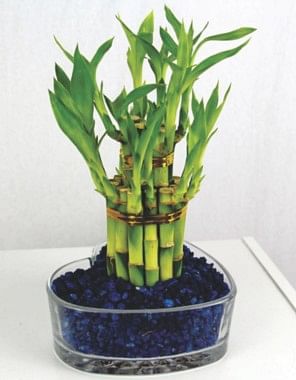Lucky Bamboo
 In the past few years this beautiful plant became our favourite indoor friend. The miniature bamboo is just simple, magical and beautiful. We like to see this nicely decorated, meticulously structured plant in our work desks, book shelves, basin tops and other similar spaces. Nowadays, this plant is available in different shapes and styles in boutique shops, super market corners or florist outlets with prices depending on the creativity and design of the artefacts.
In the past few years this beautiful plant became our favourite indoor friend. The miniature bamboo is just simple, magical and beautiful. We like to see this nicely decorated, meticulously structured plant in our work desks, book shelves, basin tops and other similar spaces. Nowadays, this plant is available in different shapes and styles in boutique shops, super market corners or florist outlets with prices depending on the creativity and design of the artefacts.
Why is this bamboo called lucky? Our lucky bamboo is also known as Ribbon Dracaena, Belgian Evergreen or sometimes Ribbon Plant. It is a member of the lily family that grows in the dark, tropical rain forests of Southeast Asia and Africa.
According to ancient Asian traditions the lucky bamboo brings a balance to its environment, encouraging love, happiness, health and wealth. Now you too can spread these positive vibes to others.
Lucky bamboos are of a wide variety of styles: straight, spiral, curly, towers, heart-shaped, woven trees and more. Lucky Bamboo comes from professional growers of Taiwan, Thailand and Singapore. If you are in Thailand or Singapore, be sure to buy lucky bamboo fertilisers to keep the plants growing happy and healthy!
Lucky Bamboo makes the prefect gift for a loved one, a business associate or even that someone who is hard to buy for! Wish them health, happiness, prosperity and a bright future with a bunch of simple sticks.
Go with the number to avoid any blunder
According to Chinese tradition, the meaning of lucky bamboo is tied with the number of stalks and associated arrangements of those:
Two stalks represent love, three stalks represent Fu (happiness), Lu (wealth), and Soh (long life).
Five stalks represent the areas of life that represent wealth (e.g., spiritual, mental, emotional, physical, and intuitive)
Six stalks represent good luck and wealth.
Seven stalks represent good health.
Eight stalks represent growth.
Nine stalks represent great luck.
Ten stalks represent perfection
Twenty-one stalks represent a powerful blessing.
Lucky bamboo plants are never arranged in four stalks. In Chinese, the word four is close to the word for death, so a gift of four bamboo stalks would be considered very rude, as if you had wished death on the recipient!
Feng shui, lucky bamboo plants are said to bring good luck and fortune, especially if the plants were given as gifts. It also helps that they have a well-earned reputation as nearly indestructible. Our lucky bamboos are available in different sizes and shapes like Spiral Tower, Trellis, Butterfly, Heart and in many more shapes. More in the next episode!
Answers to gardening queries
Q1) I need to use a lot of pesticide; my lemon, green chilli, anar and also my eggplant and mango leaves are all curled up... please write something on pesticides, why pests attack and how to prevent them, etc.
-- Dora
Dear Dora,
Thanks for sharing your problems. After reading your mail, I just checked on my plants growing on our roof potted in drums or earthen containers. I can share my experience that when the soil is too tight, it becomes low on nutrients, packed as it is with too many plants and shrubs and in this condition it is difficult for plants to adjust and be healthy during changing weather. I also frequently see the leaves or branches become curly and shrunk, significantly slowing the growth of my plants.
In my experience (as I am learning by doing) I observed that too many weeds and generally a crowded habitat around the plants invite unwanted elements like insects, fungi, etc. Over-watering also causes harm to the plants. It is true that plants are deprived of a natural environment when we force them to grow in an artificial and limited environment and expect them to produce our desired or cherished results. Anyway, it is love for our plants that make us compromise.
We need to look at the need of that particular plant -- whether it is getting too much or too less of water or sunshine. Aerated and clean soil is the precondition to growing healthy plants. Keep the area free of dampness so that it does not invite the unwanted elements mentioned above. Even then, the harsh and changing weather can badly affect the plants in the form of attacks of fungal infections and insects.
Usually in this season, a form of fungal growth manifested in a white, powdery substance cover the new or old shoots, especially on eggplants, mango and aanar shoots. Speaking from personal experience, eggplants are attacked by this form of pestilence when they have just settled down in their pots and when they become old.
 During the initial period when they were attacked by fungus, I had to remove the affected part and give some extra food like cow dung and check the soil, etc. But when the main stem is attacked (by gubre poka or some such pest), the roots are damaged, infected and infested from inside the stem, so there is no other option but to root out the plant and let the soil dry out. You must remember to disinfect the soil before planting a new sapling. I heard that during the mukul flowering season the mango, litchi or such plants -- particularly the old branches -- become more susceptible to this attack because of the changing weather, variation of fog and temperature and the dusty wind which bears harmful elements. As a preventive measure, it is better to spray light insecticides before the season starts when we feed our plants with fertiliser to prepare them for the upcoming season.
During the initial period when they were attacked by fungus, I had to remove the affected part and give some extra food like cow dung and check the soil, etc. But when the main stem is attacked (by gubre poka or some such pest), the roots are damaged, infected and infested from inside the stem, so there is no other option but to root out the plant and let the soil dry out. You must remember to disinfect the soil before planting a new sapling. I heard that during the mukul flowering season the mango, litchi or such plants -- particularly the old branches -- become more susceptible to this attack because of the changing weather, variation of fog and temperature and the dusty wind which bears harmful elements. As a preventive measure, it is better to spray light insecticides before the season starts when we feed our plants with fertiliser to prepare them for the upcoming season.
This is why we prune the branches after the harvest -- to allow new branches to grow with vitality and freshness. But to save the seasonal plants like eggplant, tomato, chilli or potato, the only remedy is to remove the damaged or affected part or even the entire plant. I use insecticide once a year or before the season but I try to check each of the plants at weekly intervals. Sometimes I wipe or clean the affected part/leaves by hand and wash it. My mother advised that it is good to spray old ashes on the plants when they grow (not for mangoes and similar plants, but only for the bean types and seasonal vegetable plants).
For any plant lover, it is important to keep every plant under close observation and perform a weekly maintenance, if possible. Please take a closer look at your individual plants and try the very deshi method of care.
Q2) I enjoy reading your write-ups on Lifestyle, more so because you write in the Bangladeshi context. Most gardening and plant care information on the web is from a Western perspective. I have a monstera plant at home which was beautiful when I purchased it. But for almost six months now, it has not grown any new leaves. And the leaves are also drooping. How do I revive it? Also, where can I find sandy potted soil here since monstera requires such soil? Thank you.
-- Shonali
Dear Shonali,
Thank you for your appreciation. About your monstera, it seems the place or pot you have planted it in is not suitable. As far as I know about this plant, it grows like our money plants. I have seen this plant growing well and climbing walls without any care in some old houses in Gulshan.
This is a very tolerant plant that grows well in our climate, but better in slightly shaded locations as strong sunlight hurts its leaves. On the other hand, too much shade and too little sunlight also does harm. Excess water, damp soil or or an excessive diet of fertilisers may cause damage to the root, the first sign of which is the shedding of the leaves. This is applicable to all plants -- if the plant is kept indoors, please put it close to the window so that it has access to some sunlight everyday and check the condition of the soil to see whether if it is too watery; it should just be a little moist.
This type of plant does not need daily watering; just let the soil have water as it gets thirsty -- at regular intervals. Clean the healthy leaves with a soft piece of cloth to remove the dust from the leaves. Make the soil airy with a shovel once a week or so and let it have air and sunlight together. You may put some amounts of dry cow dung or a spoon of urea fertiliser -- but not close to the main stem -- at the upper soil. You may mix this with the soil and pour a little water so that it gradually reaches the root.
Usually plants like monstera do not suffer from diseases or insects. Only regular care will do. I do not think you need to buy any kind of special, sandy soil to give an artificial life to any plant we grow. It will grow in our mixed soil -- a mix of cowdung or a little bit of urea and loose soil should be all that is required. Try this for two-three weeks; if you do not see any result take the plant to the nursery and ask them to do the needful. If the root is affected, cut that part and replant in a new pot and allow that to grow in good condition.
Please feel free to send me emails to share your thoughts, feedback, and photos of your garden, or to tell your story; or ask a question on the garden issue. Email: [email protected]

 For all latest news, follow The Daily Star's Google News channel.
For all latest news, follow The Daily Star's Google News channel. 



Comments